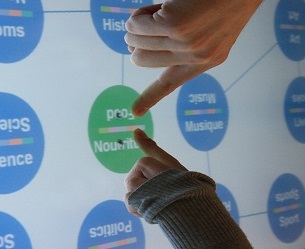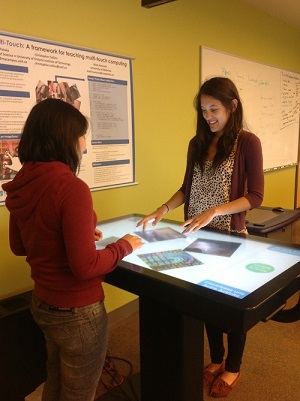Human-Computer Interaction & Information Visualization
TandemTable — Honours Undergraduate Thesis
A Multi-touch
Computer-Assisted Language Learning System for
Dyads
September 2011 – June 2014
Technologies: Java using my toolkit (Simple Multi-Touch), Processing,
Web Services, Digital Signal Processing, TUIO
Lab Project Page: https://vialab.ca/research/tandemtable
TandemTable: Supporting Conversations and Language Learning
Using a Multi-Touch Digital Table
In Proceedings of the 2015 Graphics Interface Conference (GI '15)
Augmenting tandem language learning with the TandemTable
In Proceedings of the 2013 ACM international conference on Interactive tabletops and surfaces (ITS '13)
Enhancing Tandem Language Learning Using an Interactive Tabletop
Honours Undergraduate Thesis — University of Ontario Institute of Technology

Study 1:
Conducted a participatory observational study of a tandem language learning environment (Conversation Café), as well as interviewed its administrator and four participants.

TandemTable:
Designed and implemented a computer-assisted language learning system called TandemTable. Designed for two co-located tandem language learners, the system suggests and grounds conversations on user-specified themes/topics, and provides digital media artifacts that contain up-to-date content delivered straight from the web. Web services, such as Bing Translator, Diffbot, Feedzilla, YouTube, Twitter and Flickr, were harnessed to achieve TandemTable's functionality.

Study 2:
Conducted an exploratory evaluation study with university undergraduate and graduate students to evaluate TandemTable. Subjective data was gathered through pre- and post-interviews and questionnaires, including Likert scales, along with observational and interaction data.

Refinement:
With the insights gained from the exploratory evaluation, TandemTable was refined, which among others, included adding voice activity detection (VAD) by adding microphone support and implementing digital signal processing (DSP) algorithms.

Study 3:
Evaluated TandemTable quantitatively with a within-subject comparative study. Language learners' utterance rates were measured and compared between conditions. The conditions involved employing TandemTable as a learning aid, as well as having no computer-assistance which is the standard method in tamdem language learning.

